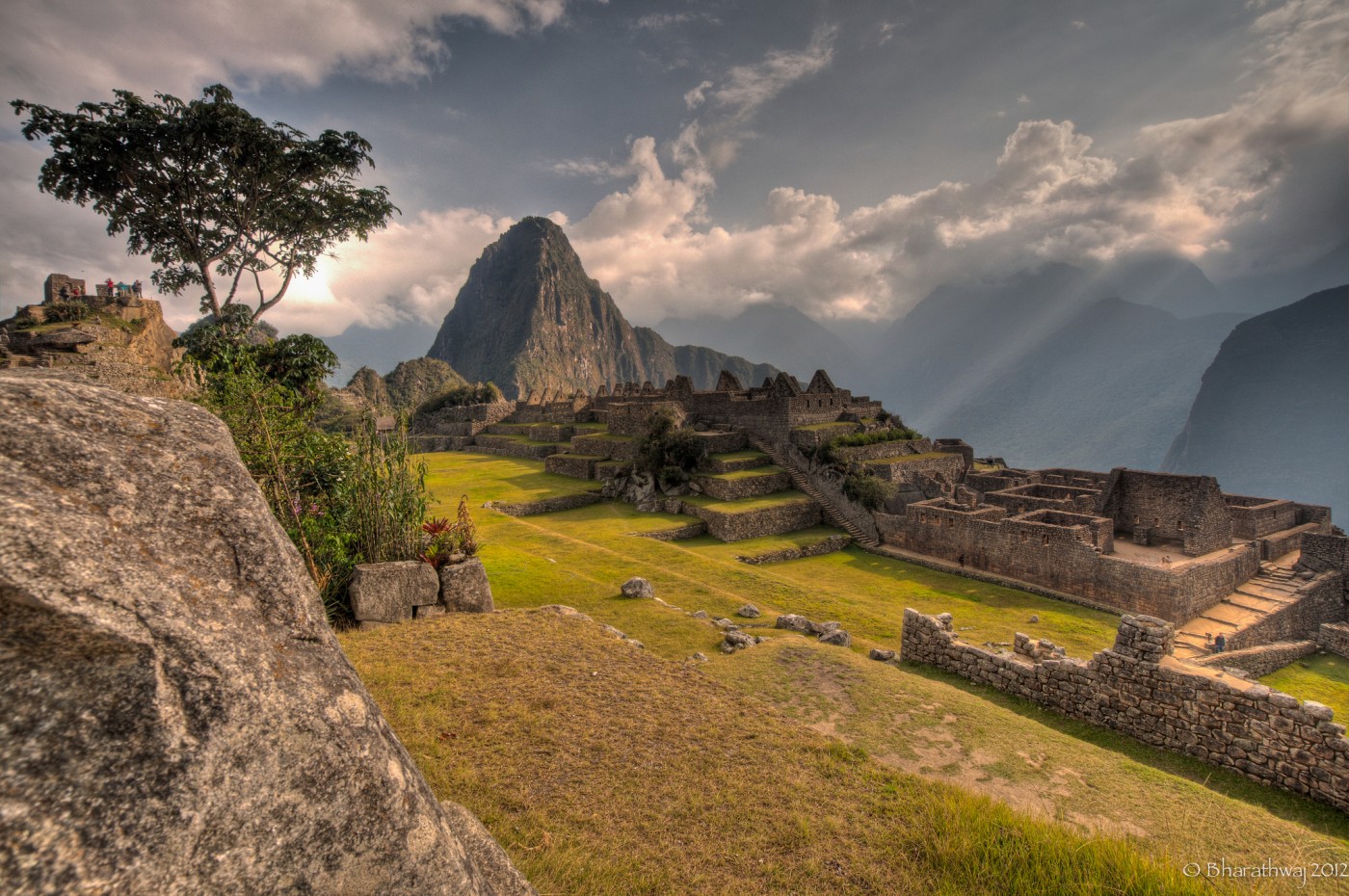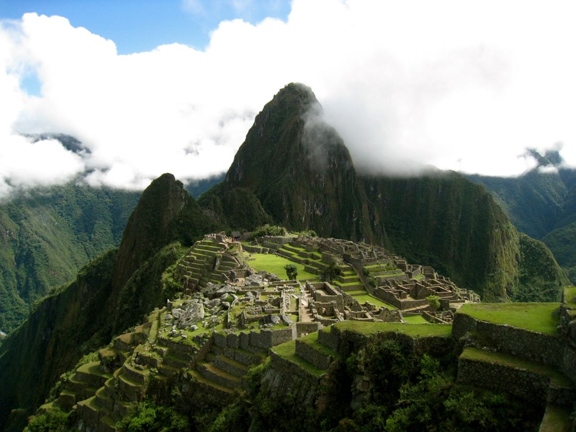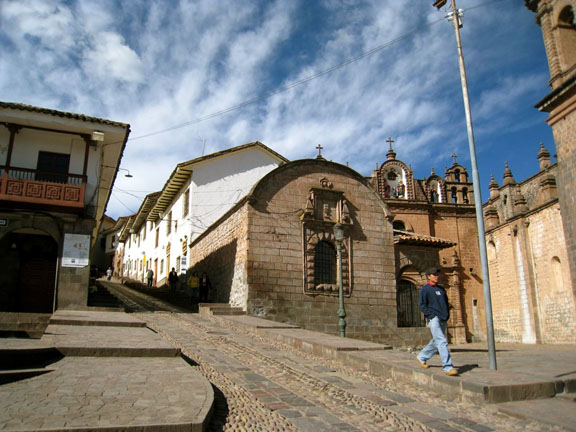
We napped for a few hours (the second step in staving off altitude illness), then slowly wandered the streets that felt older than dust down to the Plaza de Armas, where we stumbled into a wonderful coffee shop (the Cappucino Café on the second floor off the plaza) for a view over the square: the La Catedralchurch across the street; mothers carrying their babies on their backs in colorful woven mantas blankets; businesspeople in suits and shined shoes heading to and from Avenue el Sol leading to the modern downtown; teens schilling their artwork and Peruvian wool hats, and tourists saying, like we would, “No, gracias, no gracias” to vendors down the block.
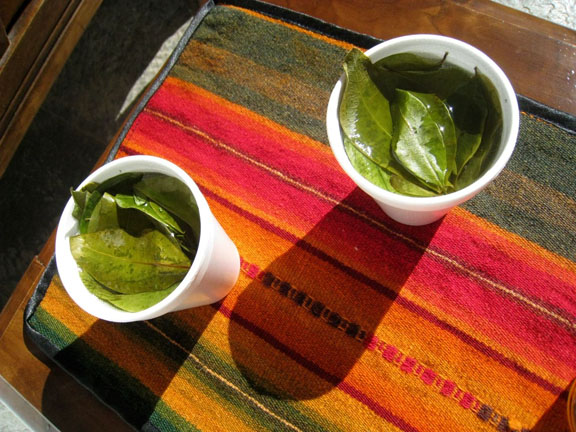
We took up some young local women on their offers for full-body massages in one of the small second-floor spas around the square (we liked the Inti Spa on Portal de Panes 123 for a remarkable $7 per person per hour—plus a hearty tip). We then had some stewed alpaca for dinner—not brave enough to try the cuy, which is guinea pig, often fried whole, heads, claws and all—and early the next morning, we headed out for Machu Picchu. My tip: Give yourself a chance to explore Cusco, to wander the ancient streets, walk up blocks of stone steps further up into the hills and along grassy walls and into one more of a dozen stunning iglesias(churches) dotting the town, or for a taxi ride up to the walled ruins of Sacsayhuaman high in the hills above Cusco. Also: We had our hotel hold our luggage and traveled with just a backpack holding necessities for two days, including: Hiking shoes, shorts, a rain poncho, sunscreen and Peruvian soles in cash so you’re not socked with additional credit card charges at the base of the ruins.
THE SACRED VALLEY—SOME WORTHY SIDE TRIPS
During our visit, the train tracks were still washed out from the mudslides of January 2010, so instead of taking the train straight to Machu Picchu, we hired a taxi to drive us two hours to ancient ruins of Ollantaytambo (for a mere $50 US). I’m so glad we did! Along the Sacro Paradero (the Route of the Sacred Valley), the views changed from small built-up towns to lush fields of cows, pigs and donkeys; from women in tall, weathered top hats and children in school uniforms to farmers working the papas (potato) fields. We asked our driver to stop at a few worthwhile vistas along the way. At Ollantaytambo, we walked up the lush green terracing of the ruins and rested for an outdoor lunch of fresh trout from the Urubamba River at Tawa Chaki at the base of the ruins. My tip: Build in an extra day like this to visit some sites in the Sacred Valley, which also include the towns of Moray, which has circular farm terracing akin to alien crop circles, Pisac and Chinchero.
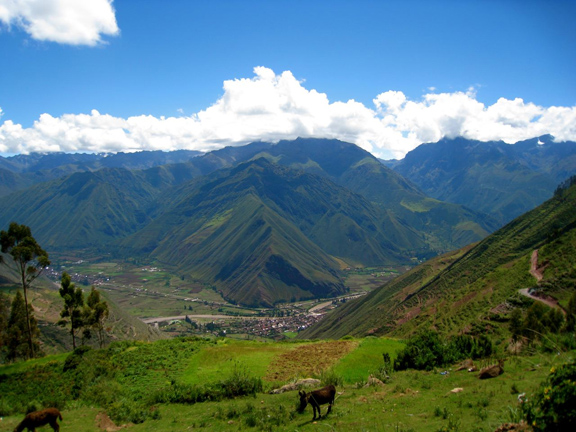
Our taxi dropped us at the Piscacucho train station, and we took the Peru-Rail train (around $60 per person one way), which ran about an hour and a half, snaking between the hills and along the brown Urubamba river while they serve snacks and coca tea. My tip: Grab a seat on the left, the river side; and if the glass-roofed Vistadome train is available (an additional $15-$20) spring for it, as the ride is long and slow, and worth good views;. Also: Book your train tickets as far in advance as possible, as the schedule is scant and will sell out. We hit our destination at dusk.
MACHU PICHU TOWN—TO LAY YOUR HEAD
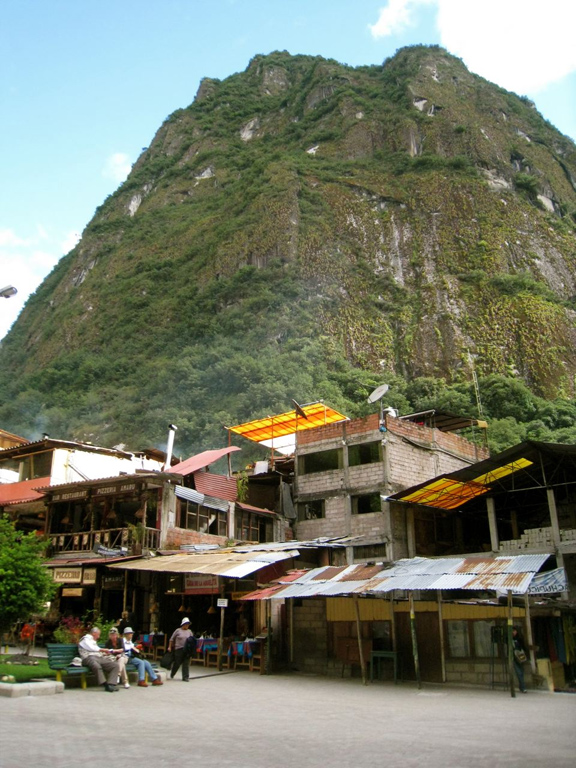
The town of Aguas Calientes, or “Hot Waters,” (and sometimes called Machu Picchu Town) is a ramshackle village for tourists, built, it seems, from rickety wood, concrete, corrugated metal and plastic. But the view (of the tropical South Peruvian mountains), the scent (of burning wood stoves) and the sound (of the rushing river, here called the Rio Vilcanota) are all enchanting. We walked from the station through the flea market packed with vendors selling Peruvian hats, socks, alpaca skins and slippers, magnets and figurines.My tip: We found these items to be cheaper by a few dollars in Cusco, which adds up when you’re buying gifts, but this market has utterly everything. Our favorite purchases were our gotta-give-in-and-get-‘em Peruvian wool hats, and my alpaca fur hat and slippers.
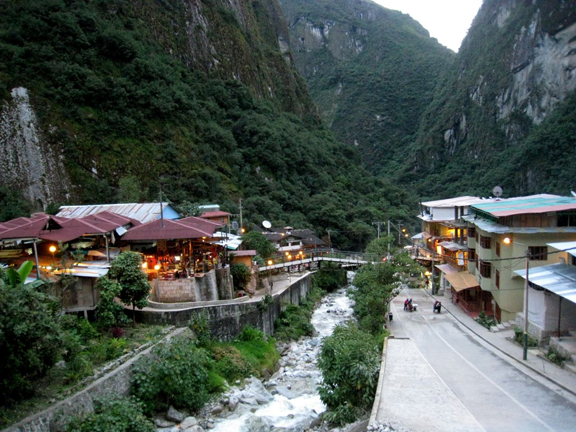
We bought our tickets for the Machu Picchu site (around $45 each) as well as the bus to the site ($14 round trip) as soon as we arrived so we didn’t end up in a long line the next morning when we were under pressure to catch the bus; you cannot buy a ticket at the entrance to the site. Then we hiked up the hillside to our suite at the eco-based Rupa Wasi lodge where five rooms are built like treehouses into the hillside, providing views of the roofs of town and the surrounding mountains ($100 US per night, it’s for outdoor-lovers only, as close to sleeping in nature as it gets).
The majority of restaurants in Aguas Calientes are super touristy—as in, designed to please every possible tourist palate, like a jack of all foods, master of none. But there are a few gems (see the “Where to Eat” below) serving local fresh food like alpaca and river trout and potatoes from the local farms we saw along the drive. Our favorite of the touristy town square spots was Yakumama for brick oven thin pizza.
We woke at 4:30 a.m. for breakfast and picked up pre-ordered “lunch boxes” from our hotel restaurant for the mountain (for $8 US each). My tip: Arrange this or ask your hotel to do the same; it’s a perfect way to allow yourself more time on Machu Picchu without having to exit the site for the overpriced snack bar or the restaurant at the hotel atop the ruins. Because we had our bus and site tickets, we headed directly to the line for the dozen of 5:30 a.m. buses. If you’re up for the hike to the top of Huayna Picchu, the mountain pictured in the background of iconic Machu Picchu photographs (see “Must-Sees” below), this is the bus to take.
An early morning mist covered the tops of the hills, adding an eerie glow to the dark blue dawn sky, as the bus wound its way along the river, then up a jack-knifing trail along the side of the mountain. We pulled into the site thirty minutes later. As you exit the bus and get on line for the site, you’ll notice people rushing past you; they’re headed to a secondary line that marks your ticket for access to the Huayna Picchu hike. My tip: Follow those people! The site only allows 400 people a day to do the hike (one trip at 7 a.m., another at 10:30). My tip: I recommend the 10:30 a.m. hike, which allows the sun time to clear out the mist for the million-dollar view you panted your way up for. We got our tickets stamped for the hike and our passports stamped with the ruins and entered the Machu Picchu site as it was bathed in mist.
THE RUINS OF MACHU PICCHU—WHAT YOU CAME FOR
Machu Picchu, which translates as “old mountain,” was first mapped and named in 1874, but re-discovered in 1911 as the “Lost City of the Incas.” It spreads over three square miles with forest, houses, cultivation terraces, temples, and military and astronomical observatories. We got lost walking through the labyrinth of stone rooms and up and down the steps. My tip: You can find tour guides standing outside the front gate offering to take you around (for around $20 US), but we bought a tiny guidebook at the base of the mountain so we could wander on our own with nothing but the sound of the rushing river, and the chirping of small birds.
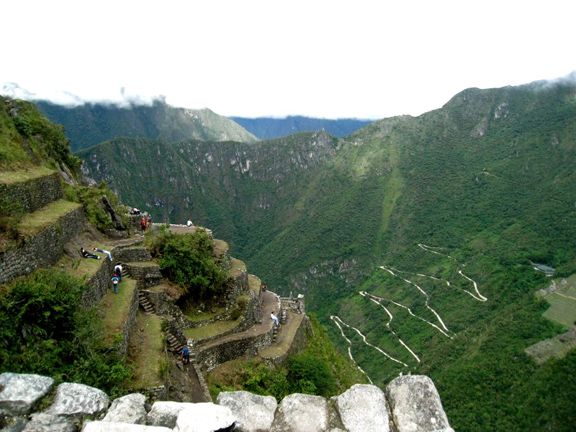
Within the site, see the Main Door, the Temple of the Sun, the Temple of the Condor, the Intihuatana sundial, the funerary rock and the Watchman’s House, which offers incredible postcard-worthy views of the site. The granite quarry was devoid of tourists and offered a sense of standing alone on what felt like the edge of the world. We walked the trail to the Inca bridge, which took about thirty minutes round trip and offered a few nail-biting moments when we had to grab onto a rope to step along one mountain ridge. In the late morning, just minutes after the sun broke through the mist and lit up the ruins, we headed off toward our big hike.
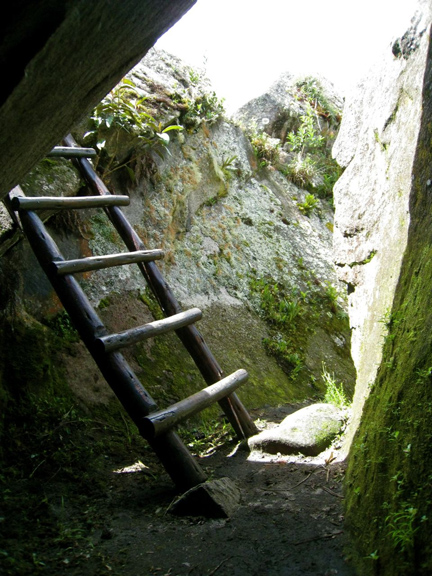 The hike up another 1,180 feet up Huayna Picchu (also spelled Wayna Picchu, meaning “Young Peak”) is steep and challenging, guided with ropes and handrails, but allows for rest as much as you want. At the top, there are some vertigo-inducing moments as you scramble up onto rocks where you can rest in a “They’d never let us do this in America” kind of way. At the summit, we found a spot on a big rock for a view above the clouds where we were met with the most exquisite site: tiny colorful butterflies flapping around our heads by the hundreds. We ate our boxed lunch sitting on a wall of the ruins at the lookout point, overlooking the Machu Picchu site far down below. After a few cervezas in town that night and a good rest, we went up to the site again and visited parts of the ruins we didn’t have time or energy to see on day one. At daybreak the next morning, we took a dip in the hot thermal pools of Aguas Calientes (reminiscent of a public town pool, it’s not a must-do), and headed back by train and taxi to Cusco for some massages and rest before heading home. My tip: Give yourself two days at the Machu Picchu site. In a place you’ve spent flights and hours to reach, it’s worth an extra day to allow yourself long spells to sit quietly and take in some of the sacred Inca energy that will stay with you far longer than your photos.
The hike up another 1,180 feet up Huayna Picchu (also spelled Wayna Picchu, meaning “Young Peak”) is steep and challenging, guided with ropes and handrails, but allows for rest as much as you want. At the top, there are some vertigo-inducing moments as you scramble up onto rocks where you can rest in a “They’d never let us do this in America” kind of way. At the summit, we found a spot on a big rock for a view above the clouds where we were met with the most exquisite site: tiny colorful butterflies flapping around our heads by the hundreds. We ate our boxed lunch sitting on a wall of the ruins at the lookout point, overlooking the Machu Picchu site far down below. After a few cervezas in town that night and a good rest, we went up to the site again and visited parts of the ruins we didn’t have time or energy to see on day one. At daybreak the next morning, we took a dip in the hot thermal pools of Aguas Calientes (reminiscent of a public town pool, it’s not a must-do), and headed back by train and taxi to Cusco for some massages and rest before heading home. My tip: Give yourself two days at the Machu Picchu site. In a place you’ve spent flights and hours to reach, it’s worth an extra day to allow yourself long spells to sit quietly and take in some of the sacred Inca energy that will stay with you far longer than your photos.
GETTING THERE AND GETTING AROUND:
For anyone planning a trip to Machu Picchu it might be helpful to use a full-service tour operator who will arrange itineraries and transportation between various cities and provide knowledgeable guides. KANΩN is an excellent one that plans a formidable 16 day cultural experience incorporating not only Machu Picchu but also Lima, Cuzco and the beautiful World Heritage city of Arequipa. They are located in Thessaloniki, Greece. KANΩN Cultural Tours & Expeditions, P.P. Germanou 22, Thessaloniki, Greece; 30-2310-237 066 or 30-2310-274-045; www.kanon.gr
The country code for Peru is 51.
WHERE TO STAY:
In Cusco:
Hotel Montesorio. Built in a former 16th century monastery, this hotel is like the L.A. Chateau Marmont of Cusco. It offers two divine restaurants (Illiray and El Tupay) a lobby bar, and elegant rooms just three blocks off of the main city square. Rates average $400 to $700 per night. Calle Palacio 136, Plazoleta Nazarenas, Cusco Peru; Tel: +51 84 60 4000;http://www.monasteriohotel.com
In Machu Picchu:
El Mapi. This modern hip hotel offers 48 rooms in the heart of town. It’s home to the minimalist and healthy La Cafeteria restaurant (which will also pack boxed lunches), the El Bar for drinks, and a back garden. Rates average $200 to $250 per night. 109 Pachacutec Ave. Machu Picchu, Cusco, Peru; Tel: +51 84 211 011; http://www.elmapihotel.com/
Sumaq Hotel. This five-star hotel, which resembles a modern condo unit, faces the Rio Vilcanota, a few hundred feet up the road from Aguas Calientes town. Its 60 rooms are for those looking for a quiet, upscale escape. Rates average $470 to $930. Av. Hermanos Ayar Mz 1 Lote 3 Machu Picchu, Cusco Peru; Tel: + 51 84 211 059; http://www.sumaqhotelperu.com/
Machu Picchu Sanctuary Lodge. For a true splurge, this is the only hotel that rests atop the mountain, nestled beside the entrance to Machu Picchu. It offers the Tampu restaurant and the Tinkuy buffet restaurant. Rates average $800 to $1000 per night. Machu Picchu, Cusco, Peru; Tel: +51 84 984 816 956 (or toll free from the US: 800 237 1236); http://machupicchu.orient-express.com/web/omac/machu_picchu.jsp
WHERE TO EAT:
In Cusco:
Inka Grill. The style of it seems touristy, but the warmly decorated room and authentic menu is a great spot to dabble in some local Andean cuisine. On the Plaza, Portal de Panes, Cusco Peru; Tel: +51 84 262992; http://www.inkagrillcusco.com/
MAP Café. This modern, minimalist glass and steel restaurant is an elegant choice located within the Museo de Arte Precolombino, offering an Andean prix fixe menu.
Plaza Nazarenas, Cusco, Peru; Tel: +51 84 242476; www.map-café.com
Papillon. This quaint, casual second-floor spot on the northeast side of the Plaza de Aramas overlooks the square and is perfect for affordable local food, a personal pizza or some cold beers in the open windows. Portal de Carnes, Cusco, Peru
In Machu Picchu
Tree House Restaurant. Located at the Rupa Wasi Condor Eco-House hotel lodge, it’s a challenge to find (it shoots off from the main square) but well worth it. It’s modern wood design and delectable food makes it feel like a New York City West Village gem dropped in Peru; Huanacaure 180, Aguas Calientes C1, Peru; Tel: +51 84 211101; www.rupawasitreehouse.com/index01.html
El Indio Feliz. This cozy French-Peruvian restaurant, located on the walk up to the town’s Thermal Springs, offers a slightly more upscale three course Andean meal complete with the local cocktail: the Pisco sour. Lloque Yupanqui 4-12, Aguas Calientes, Peru; Tel: 084 211 090;http://www.indiofeliz.com/en/indio-feliz.html
Chez Maggy. To our disappointment, this cozy spot was closed during our visit, but has won many a travel blogger’s heart for its cheap tasty pizza and homey atmosphere. Av. Pachacutec 156, Aguas Calientes, Peru; http://www.pizzeriachezmaggy.com/
MUST SEE:
In Cusco
Le Catedral. The 16th century Cathedral of Santo Domingo towers above the main Plaza de Armas. It was built from stones taken from the defensive structure of Saqsaywaman in the hills above Cusco and boasts gorgeous green wooden doors and two ornate towers, one of which houses the Maria Angola bell, said to be the largest bell in South America. (Entrance fee is around $9 US.)
In Machu Picchu

